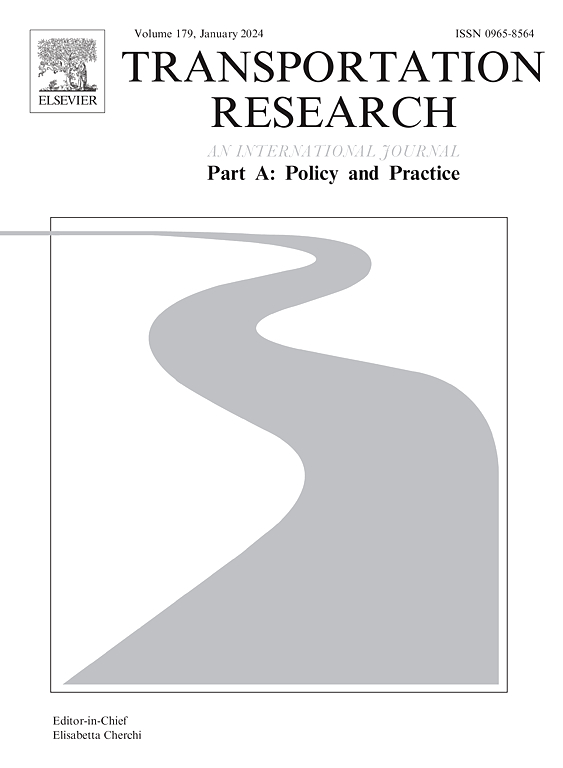Improving public transportation via line-based integration of on-demand ridepooling
IF 6.3
1区 工程技术
Q1 ECONOMICS
Transportation Research Part A-Policy and Practice
Pub Date : 2024-11-01
DOI:10.1016/j.tra.2024.104289
引用次数: 0
Abstract
Ride-sourcing companies have worsened congestion in numerous cities worldwide, as many users are attracted from more sustainable modes. To reverse this trend, it is crucial to leverage the technology of connecting users and vehicles online and use it to strengthen public transport, which can be achieved by integrating on-demand pooled services with existing fixed-line services. We propose an efficient and practical integration idea: namely, to complement fixed bus lines with a fleet of smaller vehicles that follow flexible (on-demand) routes side-by-side with the fixed routes, so that part of the demand that would have used the fixed line can ride the flexible service instead. With this scheme, a smaller bus fleet is required, partially compensating for the increase in operators’ costs stemming from the flexible vehicles. This integration strategy favors mostly two types of users: those traveling in low-demand periods, through lower waiting times, and those located far from the bus stops, because the on-demand vehicles can reduce their access time. We develop simulations in real-world scenarios from Santiago, Chile, and Berlin, Germany, for the cases of human-driven and automated vehicles. Results show that when vehicles are automated: (i) A small number of on-demand vehicles can reduce average walking times from approximately 12 to 2 min while reducing operators’ costs, leading to a Pareto improvement, (ii) A larger number of on-demand vehicles can diminish total costs by 13%–39%, through a reduction in users’ costs, although increasing operators’ costs. If vehicles are not automated, total costs are reduced by more than 10% in all of the scenarios analyzed, but a Pareto improvement is not always possible. In general, this mixed fixed/on-demand system outperforms the use of on-demand ridepooling only. Results are more promising in Berlin, because large buses are cheaper in Santiago and run more crowded, so it is more costly to partially replace them by smaller vehicles.
通过基于线路的按需乘车整合改善公共交通
乘车外包公司加剧了全球许多城市的交通拥堵状况,因为许多用户被更可持续的交通方式所吸引。要扭转这一趋势,关键是要利用在线连接用户和车辆的技术,并通过将按需集合服务与现有的固定线路服务相结合来加强公共交通。我们提出了一个高效而实用的整合方案:即在固定公交线路的基础上,增加一支由小型车辆组成的车队,与固定线路并排行驶灵活(按需)的线路,这样,原本使用固定线路的部分需求者就可以改乘灵活服务。在这种方案下,需要的公交车队规模较小,部分弥补了因灵活车辆而增加的运营商成本。这种整合策略主要对两类用户有利:一类是在低需求时段出行的用户,因为他们的候车时间较短;另一类是距离公交站点较远的用户,因为按需服务车辆可以缩短他们的到达时间。我们在智利圣地亚哥和德国柏林的实际场景中,针对人工驾驶车辆和自动驾驶车辆进行了模拟。结果表明,当车辆实现自动驾驶时:(i) 少量的按需车辆可将平均步行时间从约 12 分钟缩短至 2 分钟,同时降低运营商的成本,从而实现帕累托改进;(ii) 较多的按需车辆可通过降低用户成本将总成本降低 13%-39%,但会增加运营商的成本。如果车辆不是自动驾驶的,在所有分析的方案中,总成本都会降低 10%以上,但不一定能实现帕累托改进。总体而言,这种固定/按需混合系统优于仅使用按需乘车池的系统。柏林的结果更有希望,因为在圣地亚哥,大型公交车的价格更低,而且运行时更拥挤,因此用小型车辆部分取代大型公交车的成本更高。
本文章由计算机程序翻译,如有差异,请以英文原文为准。
求助全文
约1分钟内获得全文
求助全文
来源期刊
CiteScore
13.20
自引率
7.80%
发文量
257
审稿时长
9.8 months
期刊介绍:
Transportation Research: Part A contains papers of general interest in all passenger and freight transportation modes: policy analysis, formulation and evaluation; planning; interaction with the political, socioeconomic and physical environment; design, management and evaluation of transportation systems. Topics are approached from any discipline or perspective: economics, engineering, sociology, psychology, etc. Case studies, survey and expository papers are included, as are articles which contribute to unification of the field, or to an understanding of the comparative aspects of different systems. Papers which assess the scope for technological innovation within a social or political framework are also published. The journal is international, and places equal emphasis on the problems of industrialized and non-industrialized regions.
Part A''s aims and scope are complementary to Transportation Research Part B: Methodological, Part C: Emerging Technologies and Part D: Transport and Environment. Part E: Logistics and Transportation Review. Part F: Traffic Psychology and Behaviour. The complete set forms the most cohesive and comprehensive reference of current research in transportation science.

 求助内容:
求助内容: 应助结果提醒方式:
应助结果提醒方式:


